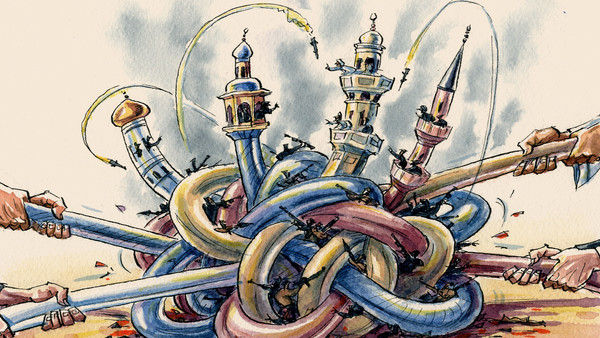How history echoes Syria’s unholy war
 ©Ingram Pinn
©Ingram Pinn
The Middle East reminds us that there is nothing so unholy as a holy war.
Europe learnt this in the 17th century. Confessional competition between Catholicism and Protestantism fused with temporal rivalry to provoke the Thirty Years’ War among the continent’s leading powers.
This should tell us something about the present conflict in Syria.
The wholesale slaughter that followed could not have been imagined in 1618, when mainly Protestant Bohemia rose up against the Catholic Holy Roman Empire. The subsequent wars — there were several — drew in Habsburg Spain and Austria, France, the Netherlands, Sweden, Poland, Russia, Denmark and the big German principalities. England, Scotland, the Ottoman Empire and Russia all claimed walk-on parts.
The fighting was mostly on German soil, but the battles were between armies of foreign mercenaries. As befits wars conducted in the name of God, cruelty and brutality were endemic.
By many accounts, the population of Germany was cut by a third or more. Torture and mass burnings of alleged witches were commonplace.
For Catholic and Protestant, read Shia and Sunni. There are, I am sure, a hundred differences between the horrors that engulfed Europe and the flames consuming Syria. There are also uncomfortable coincidences. The brutality flowing from the intertwining of the spiritual and territorial is one; the misfortune of a patch of ground — Germany then, Syria now — in becoming a battlefield for outside powers is another.
Confessional loyalties were sometimes elbowed aside by secular ambitions. Thus Catholic France joined up with Protestant Sweden against its co-religionists in Spain and Austria — just, perhaps, as Shia Iran now finds advantage in allying itself with Sunni Hamas. Protestant Denmark fought at different moments on either side of the confessional divide. Competing Lutherans and Calvinists
By 1648, the wars had recast the geopolitical balance. France emerged a victor, the Holy Roman Empire a loser. Westphalia became a foundation for the modern European state. If there was a thread running through the various treaties that settled the territorial disputes it was that the confessional choices of states should no longer be a casus belli. Today’s Middle East, with the same combustible mix of theological and earthly rivalry, is a long way from reaching such an understanding.
One way of looking at the fighting in Syria is an uprising of the majority Sunni against the Alawite, or quasi-Shia, regime of Bashar-al Assad. This is the obverse, you could say, of what happened in Iraq: the fanatics of the self-styled Islamic State have prospered with the support of Iraqi Sunnis dispossessed by the toppling of Saddam Hussein.
Recep Tayyip Erdogan, Turkish president, talks about the enemies of Mr Assad as his “Sunni brothers”. But the shooting down of a Russian jet by Turkish warplanes patrolling the Syrian border has little to do with rival versions of Islam. Ankara’s fear is the emergence of a powerful Kurdish entity in northern Syria and Iraq — a concern that explains its dangerous ambivalence towards Isis. Russia, like the US and Europe, sees Isis as a serious threat, but does not want to risk losing its Mediterranean naval base.
For the US and its allies, the overarching interest is the re-establishment of regional stability and the defeat of the Isis jihadis. But this is a conflict that defies partial solutions. An eventual peace will demand the unravelling of the confessional and the temporal — that religion surrenders to realpolitik.
The Gordian knot is the struggle between Iran and Saudi Arabia, but a settlement would have also to acknowledge Russia’s interests and Turkey’s fears. Impossible, many will say. Maybe.
But until it happens, today’s Syria will live the horrors of 17th-century Germany; and Isis will continue to find a safe haven for its twisted credo.
0 comments:
Publicar un comentario